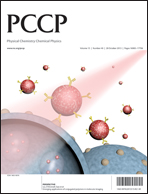How ligands improve the hydrothermal stability and affect the adsorption in the IRMOF family†
Abstract
Metal–Organic Frameworks are considered to be the next generation of sorbents both because of their synthetic versatility and high selectivity potential. In the first generation (IRMOF), the main drawback for commercial implementation is the lack of hydrothermal stability. Even if several studies have been conducted to elucidate the reasons behind their structural weakness in humid environments, how apparently small changes in the stoichiometry of the building units affect the stability of the lattice is still poorly understood. Using density functional theory and ab initio molecular dynamics we investigated the reason behind the different behaviour of several substituted IRMOF-1 structures. We show that hydrophilic variations in the organic linkers work as new basins of attraction for the incoming water molecules, thus depleting the water content at the metal center. To confirm this, we performed Monte Carlo simulations to provide insights into the adsorption energies and check the effectiveness of the adsorption sites in the substituted structures for a variety of polar and non-polar molecules. The results show that linker modification affects molecular adsorption and can improve the overall stability of the lattice redirecting water to the new sites in the case of hydrophilic units. Three key parameters have been singled out to rationalize this behaviour, and used to predict the favoured adsorption sites in the case of gas mixtures.


 Please wait while we load your content...
Please wait while we load your content...